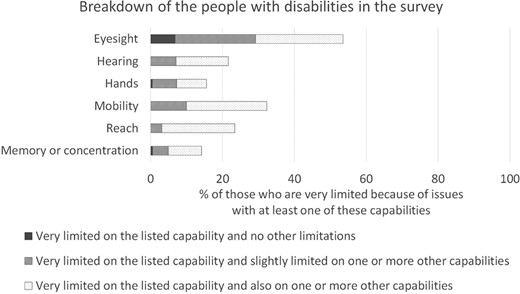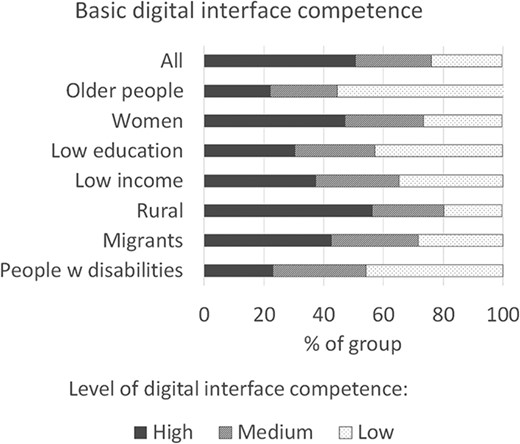Abstract:
The article considers inclusive programming from the point of view of different disabilities, the needs of people with such disabilities, and solutions to their problems.
Keywords: inclusive programming, software development, navigation, subtitles, interface, screen reading
Inclusivity in the digital space is important to ensure equality of opportunity and access to information for all users. Many people may have difficulties in using digital technologies due to a lack of knowledge, experience, or disability. In Germany, a study was conducted in 2020 that investigated a number of characteristics that influence reduced digital mobility, such as access to and use of technology as well as basic competence in digital interfaces. Below is the distribution of people with disabilities among those who participated in the survey.

Inclusive programming involves developing software with diversity in mind: creating applications and websites that are accessible and usable by all, including people with different special needs. Such programming uses accessible technologies and proper organization of the user interface and takes into account the specific needs of users with disabilities. For example, it uses improved navigation, increased text readability, and other aspects. Let's take a look at specific user issues, how they can be addressed, and the challenges that can be encountered.
Mobility
Musculoskeletal disorders are considered the leading cause of disability worldwide. Musculoskeletal disorders significantly limit a person's mobility and motor skills. Such problems can mean difficulty using a mouse or keyboard, limited range of motion, or prolonged holding.
To address these problems, it is necessary to provide alternative methods of navigation, such as keyboard commands and voice control. Large and easily clickable interface elements need to be created. Note that implementing alternative navigation methods may require additional technical solutions and changes in the application architecture. To solve this problem, it is necessary to know the techniques of working with assistive technologies and to know specialized APIs for working with additional hardware like accelerometers.
Vision
Vision problems affect more than 2.2 billion people worldwide. These can range from poor vision or blindness to difficulty seeing colors or small fonts.
Ways to address such problems would be to use alternative text for images to describe their content, support screen reading, the ability to scale the interface, and the use of complementary color schemes. Implementing these elements requires careful monitoring and adaptation of graphic content, knowledge of markup languages to create adaptive and accessible graphic elements, and the use of additional testing strategies.
Hearing
According to the statistics of the World Health Organization, there are 466 million people in the world with disabling hearing loss. Problems in this area can range from complete deafness or hearing limitations to difficulties in comprehending audio messages.
Subtitling or transcription for audio and video content helps to solve this issue. A programmer can add support for subtitles and transcription, which, in turn, may require integration with special libraries and technologies for audio and video processing. And this requires knowledge of multimedia formats and corresponding libraries.
Cognitive Features and Technological Limitations
According to WHO statistics, every year, around 10 million people with cognitive impairments reach a degree of dementia worldwide, and more than 50 million people have already been diagnosed with this condition. People with such peculiarities may have problems concentrating, memorizing information, or processing complex commands. Separately, let's add here developments for people with limited computer or mobile device skills, which also require attention.
To facilitate their experience of using programs, you need to provide a simple and intuitive interface that is not overloaded with information. Provide hints and instructions for actions. However, creating a simple and intuitive interface requires a deep understanding of usability and ergonomics principles and may require additional effort in design and development.
Age
Age is a key factor affecting the digital divide. The study mentioned above found that older people report significantly lower levels across all measures of technology access, use, and competence. Age-related issues are complex and combine various changes such as visual, hearing, cognitive, and other deterioration. As seen below, older people and people with disabilities have the lowest rates of basic digital competence. To address these challenges, integrated measures that enhance information perception, ease of use, and usability should be utilized in an age-appropriate manner with appropriate design principles.

Language Barriers
According to the 2019 study, 54% of all sites were in English, and only three more languages crossed the 5% bar. There were 40 languages on 99.9% of all sites, and all other languages were used on less than 0.1% of sites. Lack of proficiency in a particular language creates language barriers in getting information and using applications.
A programmer can implement functionality to translate content and interface into different languages. However, implementation of multilingualism may require specific approaches to localization and knowledge of tools for localizing applications with a multilingual interface.
Limited Internet Access
In 2023, the number of Internet users worldwide is 5.18 billion, which means that about one-third of the world's population is not currently connected to the World Wide Web. In addition, many users face slow connections, limited traffic, and the use of outdated or underpowered devices.
To make it easier for them to access the Internet, developers need to provide easy navigation and fast page loading and minimize the use of data-intensive resources. A programmer can optimize resources and use compression, asynchronous loading, and other tools to ensure optimal performance with limited connection speeds. This may require additional effort on detailed analysis and optimization of resources plus knowledge of how to improve performance under conditions of limited connection speeds and low processing power of devices.
Inclusive programming seeks to address the diversity of user needs in order to make software accessible to as many people as possible. As we may see, solutions vary depending on the specific task at hand and require a combination of technical skills with an understanding of the needs of diverse users. All these aspects need to be considered when developing software and websites to make them as accessible as possible to different categories of users. It is also important to test the developed software with a diverse audience to identify and fix accessibility issues.
Sources:
- Internet usage worldwide — Statistics & Facts, Statista (https://statista.com)
- Building accessible solutions and services for a more inclusive future, Microsoft Partner blog (https://blogs.partner.microsoft.com).
- Toward Inclusive Digital Mobility Services: a Population Perspective, Oxford Academic (https://academic.oup.com)
ⓒ 2025 TECHTIMES.com All rights reserved. Do not reproduce without permission.




